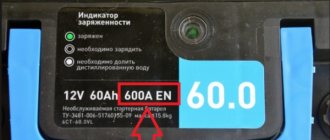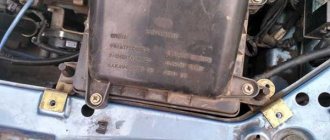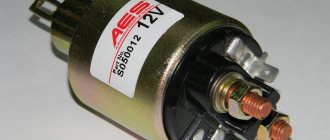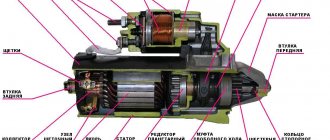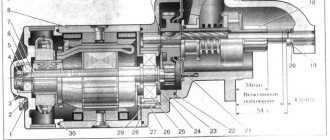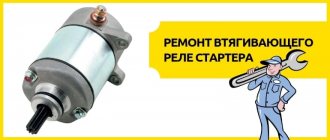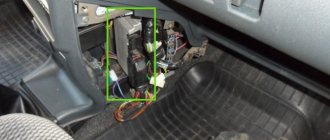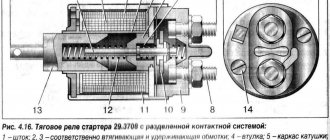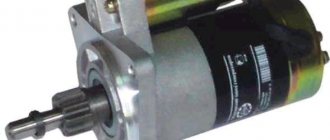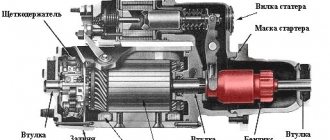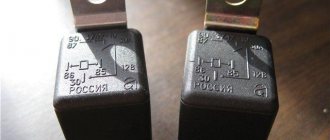“What is the starting current of the battery and starter. How much current is needed to start a diesel engine?
When choosing a battery, buyers always pay attention to the magnitude of its starting current. Some believe that this is the current that the starter will consume if this battery model is used.
In the electrical circuit of the battery - starter, the battery has its own internal resistance (2-9 mOhm), the connecting wires and terminals have resistance (0.003 Ohm), and the starter itself (DC electric motor) also has internal resistance (insignificant at rest, and at the moment of rotation much higher). The starter, terminals, wires are resistors that limit the battery current in the circuit. There is also a voltage drop at the starter “resistor”. For powerful diesel starters, Rin is low (6-10 mOhm), for starters for gasoline engines it is higher (20-30 mOhm). Typically, the resistance of the starter and power wires should be 1.5-2 times greater than the internal resistance of the battery. This is necessary so that the voltage during startup does not fall below 9 Volts, which means that the operation of the ECU, sensors, and executive electronics of the car is not disrupted, in addition, so that too high a current is not supplied to the starter. As can be seen from the oscillogram in Fig. 2 at the beginning of the start (the starter is just starting to rotate and has almost no resistance R), the current in the circuit is 360 Amperes and the voltage at this moment is 8 Volts. If there was no resistance from the wires and the starter, then a current of 450 Amps and a voltage of 7.2 Volts would be recorded. Then the starter electric motor with a power of 0.8 kW begins to rotate and its Rin increases, the current in the circuit decreases, and the voltage increases. If we do not take into account the initial moment from 0 sec to 0.05 sec, then in our case the starting current at the starter is 150-100 Amperes and the voltage at this moment (before the car generator starts working) is 10-11 Volts.
The figure shows an oscillogram of voltage and current taken from the starter at the moment of starting a 1.5 liter gasoline engine. The battery has a capacity of 60 Ah with a starting current of EN 450 A. In this case, starting the engine took 1.2 seconds. During this time, the engine managed to spin up to 200 rpm with the starter. The current graph is red (unit Ampere). The voltage graph (unit Volt) is colored blue.
To begin independent operation of a car engine, it is necessary to create an initial or starting speed for it, i.e., start the engine. The starting speed depends on the type of engine: 40 - 70 rpm for gasoline engines and 100-200 rpm for diesel engines. Therefore, to start, you need to spin the shaft to at least 40 rpm in a gasoline engine and up to 100 rpm in a diesel engine. Modern starters spin the crankshaft to a speed of 180 rpm within a second.
The current needed to start the engine using a starter is called starting current. The current written on the battery label is called cold cranking current. TCR is the maximum battery current when only the internal resistance of the battery is taken into account in the circuit. With a discharged or old battery R ext. higher, which means TCP lower. The starting current will always be less than the cold cranking current, since 2 resistances are added to the electrical circuit: power wires and the starter. That is why it is important to monitor the cleanliness of the terminals and the condition of the power wire connections. “Additional” resistance in the battery-starter system will worsen the start.
The graph shows the characteristics of a starter designed to start VAZ 2101-2107 engines with a rated power of 1.6 kW. The graph shows the dependence of rotation speed, power and torque on current consumption. Legend: M - starter torque, P - starter power, n-turns of the starter armature, U-voltage, I - cold cranking current. The diagram shows that at idle the starter has maximum speed, but the torque and power are zero. And when the armature is fully braked, the current and torque increase, and the power is zero. For a good start (in this example), the following conditions must be met: the torque of the starter must be higher than the moment of resistance of the engine, while the starter speed must be 10-20 times higher than the engine starting speed, the voltage must be about 9-10 Volts and the cold cranking current must be batteries 450-550A. From the graph you can also understand that installing a battery with a cold cranking current of 700A or higher on a VAZ-2107 will not improve engine starting. Also, installing a small battery with a THP 300A will make starting the engine difficult.
Read also: Charge a car battery from another car
Figure 4 shows the characteristics of a 0.9 kW starter. A starter of this power starts gasoline engines up to 1.6 liters in many modern cars. Different models have different characteristics, but in general they are the same.
Starters for gasoline engines have a power of 0.8-1.4 kW, and for diesel engines 2 kW or more. Starter power is indicated based on current consumption at idle speed of 4000 rpm. The rated current consumption of a 1 kW starter is 80 Amps, and 2 kW is 160 Amps. Most of the energy must be spent on overcoming the state of rest of the motor. At the moment of starting, the starter shaft is braked by the load (the engine being started). In practice, the starter at the beginning of the start (hundredths of a second) consumes a current that can be 7-10 times higher than the rated current, then in tenths of a second a current that is 2-4 times higher than the rated current. Then the starter, having gained speed, continues to “turn” consuming its rated current. After 0.8-1.2 seconds, a serviceable engine is already started. For example, to start a working 1.5 liter gasoline engine. with a 1 kW starter, the starting current is an average of 150 Amperes. Starting current for 1.5 l diesel engine. — 300 A (starter 2 kW).
When testing starters, a resistance load is used, at which the starter shaft is completely inhibited and the starting current reaches its maximum value. For a 1 kW starter, max starting current is 700 A, and for a 2.4 kW diesel starter, max starting current = 1500 Amperes.
Hot - cold engine start. A “hot” engine, in which there is fuel in the injectors, the spark plugs are dry, and the oil is heated to operating temperature, will start in a short period of time, sometimes in less than a second. Winter morning start-up will be longer since the resistance to rotation of the frozen motor shaft will be higher (more viscous oil).
With an increase in the current supplied to the starter motor, the heating of the windings increases. Large overload with high starting current leads to overheating of the starter motor windings, and there is a risk of failure. Starter manufacturers do not recommend starting attempts longer than 10 seconds. The breaks between engine starts should not be shorter than 1 minute. Cooling system for starters. absent.
The starting current of the starter directly depends on the load on the shaft - mainly on the engine volume and its compression ratio. The load inhibits the starter from spinning up to rated speed and reaching the rated internal resistance, which will reduce the current. The load size is affected by the type of engine: gasoline or diesel, its condition, age, design. Knowing the amount of starting current in your car makes it much easier to choose the right starter battery.
The starting current (cold cranking current), which is indicated on the car battery, is the current that a fully charged battery can supply within 30 seconds. The starting current of a car battery depends on the total area of its electrodes. In practice, a battery with a large number of plates, and as a result of greater weight and larger size, has a higher cold cranking current.
Important! If the battery is discharged or old, or the “battery-starter” pair is incorrectly selected, then when the engine starts, the voltage in the network will drop below 7-8 Volts. In this case, there may be problems with spark generation or the ECU may reboot (or shut down), as a result of which the start will not take place. Computer diagnostics of electrical equipment: battery, starter, generator using a motor tester.
A car starter is a device consisting of a DC motor, a clutch-disengagement mechanism, a gearbox and a control system. The clutch-disengagement mechanism and gearbox are usually called the starter drive.
The starter is intended only for short-term use cycles of 10-30 seconds.
PS In modern cars, where the engine, gearbox, and other units are completely controlled by electronics, it is important not to allow the voltage to drop below the level required for correct operation of the electronics when starting the engine. Therefore, priority is given to batteries with higher characteristics and starting current as well. However, the battery and starter must be a matched pair. A 50Ah battery with a starting current of 400A is not suitable for a powerful 2.4 kW starter. The internal resistance of such a battery will be higher than the resistance of the starter and power wires, i.e. The voltage at start-up will be below 7-8 Volts i.e. insufficient to spin the starter armature to the speed at which it can start the diesel engine, and the weak current will not be able to create the required torque.
It is not the best option to install a powerful 100 Ah battery with Rin about 3 mOhm on a car with a starter of 0.8 kW (Rin 30 mOhm). The cold cranking current of a 950 Ampere battery will be 1.5 times higher than the maximum permissible starting current (max. 600 Amperes) of the starter and 3 times higher than its “working” starting current of 250-300A. In such a tandem, due to excessive electrodynamic forces in the first 0.01 sec, the starter mechanisms will be subject to a sudden mechanical load similar to a shock. In addition, the armature winding will overheat excessively and most likely the starter will not last long.
Read also: What is Tcs in a car?
Dear visitors! If you wish, you can leave your comment in the form below. Attention! Advertising spam, messages not related to the topic of the article, offensive or threatening in nature, calling for and/or inciting ethnic hatred will be deleted without explanation.
Good afternoon The LTZ 60AV tractor has a D65 m1l engine, a standard 12 V starter, starting from 24 V, two 132 Ah batteries. connected in series. What is the approximate starting current? I am interested in choosing other, smaller batteries.
I see a picture: my EXID Premium battery glows green, but the engine can no longer turn over. Does this happen to them?
Excellent oscillogram, current load completely matches mine. I received this when taking measurements with a Hioki CM4374 current clamp.
Kamil, if you use your theory, it is physically impossible to start a car with a “crooked starter”. Any serviceable Soviet car starts in this way without any problems. No one can spin the crankshaft to 400-700 rpm with their hands.
